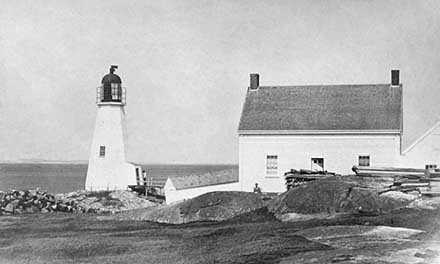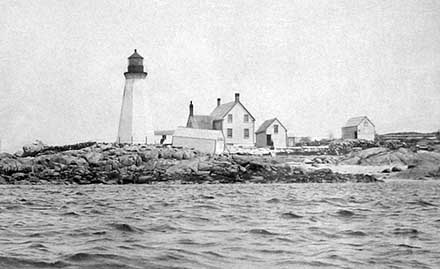Annisquam Lighthouse Lighthouse
Annisquam, Massachusetts - 1897 (1801**)

History of the Annisquam Lighthouse Lighthouse
Posted/Updated by Bryan Penberthy on 2017-04-25.
As early as 1723, the Annisquam River was considered an important harbor of refuge for vessels traveling along the east coast. To mark the inlet, Congress appropriated $2,000 in 1800, and the following year, the Annisquam Harbor Lighthouse was built.
There are differing opinions as to the origin of the name Annisquam. One opinion is that is a combination of the word Squam, which was a local Indian word for harbor, and Ann, for Cape Ann. The other opinion is that it is an Algonquin word that means "top of the rock."
The Annisquam River is a saltwater estuary that connects Ipswitch Bay with Gloucester Harbor, which separates most of Cape Ann from the mainland. Many mariners used the river as a shortcut to Gloucester Harbor, saving a trip around the cape in the open ocean.
Due to Annisquam's proximity to the George's Bank and other abundant shoals in the Atlantic Ocean, Annisquam's history dates back to 1631, when it was a fishing center called Planter's Neck. It would become Cape Ann's first fishing village, which predated Gloucester's charter in 1642 by more than a decade.
By the late 1700s, the area became an important harbor of refuge. On April 29, 1800, Congress appropriated $2,000 for a lighthouse at Wigwam Point, which the area was commonly called as it was a gathering place for the local Indians. The act reads as follows:
24. Sec. v. The secretary of the treasury shall be, and he is hereby authorized and directed to cause a sufficient light house to be erected on Wigwam Point, so called, within the town of Gloucester, in the state of Massachusetts, where it will best serve the purpose of discovering the entrance of Anesquam harbor, and to appoint a keeper, and otherwise to provide for the support of such light house, at the expense of the United States. Provided, That [sic] sufficient land for the accommodation of such light house, together with the jurisdiction thereof, shall be duly and legally granted to, and vested in the United States.
 1801 Annisquam Lighthouse (Courtesy National Archives)
1801 Annisquam Lighthouse (Courtesy National Archives)
On October 27, 1800, Gustavus Griffin sold the United States 6½ acres of land on Wigwam Point for $140, which allowed the project to move forward.
Constructed was a 32-foot wooden tower, which displayed a fixed white light from 40 feet above the water. To house the keeper and his family, a two-room wood-frame keeper's dwelling was built near the tower.
James Day was appointed as the station's first keeper, with a salary of $200 per annum. He would serve until 1805. His replacement, George Day would serve for an astonishing 45 years, from 1805-1850. To provide water for himself and his family, George Day dug his own well.
Lieutenant Edward W. Carpender was ordered to survey the lighthouses of the second district in 1838. His report told of a poorly built tower, braced on all sides to keep it standing. His entry is detailed below:
Wigwam-point or Squam-beach light - This light is made of wood, built in 1800, and is in very bad order, with the old-fashioned reflectors; it is braced on all sides with spars, to keep it erect. My opinion is, that if a new one should be erected of stone, it would be of service, as the light is very useful to navigators. The dwelling-house is also very old and uncomfortably cold. Should a light be erected, attached to the dwelling-house, costing much less than otherwise, I think it would be an improvement. The light is in as good order as it possibly can be, considering all things.
Over the course of several years, Isaiah William Penn Lewis spent time at almost every lighthouse from Maine to Massachusetts collecting facts, information, and signed affidavits from the keepers regarding the conditions of the lights.
All this information was compiled into a report that was turned over to Congress in 1843. Lewis's report was very similar to Carpender's report of 1838. He commented on how the tower was propped up by spars to keep it from being blown over and how the dwelling was "in the last stages of dilapidation."
The affidavit by George Day was very telling or the condition of the station:
The frame of the tower is rotted in all parts, and has been shored up with spars for about twenty years. In heavy gales the tower is so shaken as to be very unsafe, and I hardly know what has kept it standing...My dwelling-house is a frame building with two rooms, and a small wash-house attached; the house is exceedingly cold and uncomfortable in the winter season; is leaky and rotten, and quite as bad as the light-house...I have repaired the roof of my house several times, on account of its leaking so badly.
Although both Lewis and Day recommended that the lighthouse be rebuilt, seven years would pass before that would take place. George Day would retire in 1850, and a few months later, in 1851, a new 40-foot octagonal wooden lighthouse was built. The original keeper's dwelling was repaired and continued to be used.
 1851 Annisquam Lighthouse (Courtesy National Archives)
1851 Annisquam Lighthouse (Courtesy National Archives)
After the Lighthouse Board was established in 1852, most lighthouses in the United States were upgraded to the more efficient Fresnel lens. In 1857, the Annisquam Lighthouse received a fifth-order Fresnel lens.
Over the years, repairs were made to the station. In 1867, to allow easy passage from the dwelling to the tower, a covered walkway measuring 109 feet long was built. In 1868, two rooms and the entry of the dwelling were papered, leaks around the chimney were fixed, and the shingling on the roof of the bard was patched. The following year, additional repairs were made to the dwelling. And in 1877, it lists the station as "having received considerable repairs."
By the 1890s, the tower was in need of repair. A temporary skeletal tower was built to allow the 1851 tower to be torn down. A new 41-foot cylindrical brick tower with attached workroom was then erected upon the original foundation.
The keeper's dwelling received "extensive repairs" in 1901. The Annual Report of the Lighthouse Board had the following entry:
88. Annisquam Harbor, east side of entrance to the harbor, Massachusetts - Extensive repairs and improvements were made to the dwelling, including its entire interior rearrangement. Some 375 feet of post and wire fence, a wire fence along 3,000 feet of the boundary wall, and a stone retaining wall along the beach for a roadway, were built.
A few amenities came to the station in 1907, including connecting the station to the city water supply and telephone service. In 1922, the fifth-order Fresnel lens was upgraded to a fourth-order lens operated by electricity, replacing the clockwork mechanism.
The station received a foghorn in 1931, but after wealthy summer residents complained, it was decided that it would only operate from October 15 to May 15. In 1949, the foghorn was changed to operate year round, but only during daylight hours during the summer.
Controversy around the fog signal arose when the Coast Guard deactivated it. Some claimed it was to appease the vacationers. One fisherman collected up thousands of signatures saying "We need that horn when we're coming in, especially when our radar breaks down." In 1975, a switch to activate the foghorn was installed at the local police station, and today, it is automated, activated by a sensor.
Coast Guard keeper Roy S. Pittsley and the Annisquam Lighthouse were featured in the April 20, 1957 issue of Time Magazine. The ad was for Hardware Mutual Insurance Company and questioned, "Does a lighthouse keeper need auto insurance?"
Pittsley answered that question with the following story in the ad:
The article then when on to explain how many lighthouse keepers have automobiles to get around in the off-hours, and like any driver, they need auto insurance.Ask my family. We were out driving recently when a pedestrian stepped in our path. I spotted him and swerved...right into a tree.
Mrs. Pittsley, our daughter and I all received injuries. I certainly was glad we had Hardware Mutuals medical payments protection. We especially appreciated the personal interest the Hardware Mutuals claims man took in the case. He made sure we had a prompt settlement.
The lighthouse has been maintained over the years. Some repointing of the brick was done in the 1980s, but an inspection done in the 1990s found that the iron beams installed to support the landing below the lantern level were rusting and deteriorating. The result caused the upper part of the tower to heave and crack, letting in daylight and the elements.
Marsha Levy, a Coast Guard architect from the Civil Engineering Unit Providence came up with a plan to repair the tower. It was decided that the failing beams needed to be replaced, along with five to six feet of brickwork around the tower. The Coast Guard then contracted with Campbell Construction Group of Beverly, Massachusetts to carry out the work.
Marty Nally, a mason and the vice president of Campbell Construction Group, praised the original masons on the work they did, saying they couldn't have predicted the issues with the rusting beams. Along with replacing 3,000 bricks, Campbell Construction Group also replaced the old glass block windows and replaced the roof of the 1801 keeper's dwelling with wind-resistant shingles.
Maritime roots run deep on the Cape Ann peninsula. With that, the peninsula is home to five other lighthouses. In Gloucester Harbor sits the Eastern Point Lighthouse, the Ten Pound Island Lighthouse, and the Dog Bar Breakwater Light. Off the eastern end of the peninsula sits the Straightsmouth Island Lighthouse and the Cape Ann Lights, commonly known Twin Lights at Thacher Island.
Reference:
- Annual Report of the Light House Board, U.S. Lighthouse Service, Various years.
- The Lighthouses of Massachusetts, Jeremy D'Entremont, 2007.
- Various Government Documents, Federal & State Governments, Various dates.
- A Brief History of Cape Ann, Massachusetts: Gloucester, Rockport, Annisquam and Points Between, Peter Fortune, 2013.
- "Salute to the Coast Guard: Annisquam Light Back in Shape," Jeremy D'Entremont, Lighthouse Digest, September 2000.
- "Vintage ad is vital to lighthouse history," Timothy Harrison, Lighthouse Digest, January / February 2005.
Directions: From Gloucester, Massachusetts, take Highway 127 (Washington Street) north out of the city. Turn left onto Leonard Street, the right onto Norwood Heights Road. Stay right on Norwood Heights Road until the end. At the end, make a right and then a quick left onto Wigwam Road.
At the end of Wigwam Road, you will see a sign for Norwood Heights Beach. From here, you can walk onto the rocks to get pictures of the lighthouse.
Access: The lighthouse is owned by the Coast Guard. The grounds and tower are closed. However, there is public beach access at Norwood Heights Beach at the end of Wigwam Road. From there it is possible to get pictures of the lighthouse.
View more Annisquam Lighthouse Lighthouse picturesTower Height: 41.00'
Focal Plane: 45'
Active Aid to Navigation: Yes
*Latitude: 42.66200 N
*Longitude: -70.68200 W
See this lighthouse on Google Maps.
